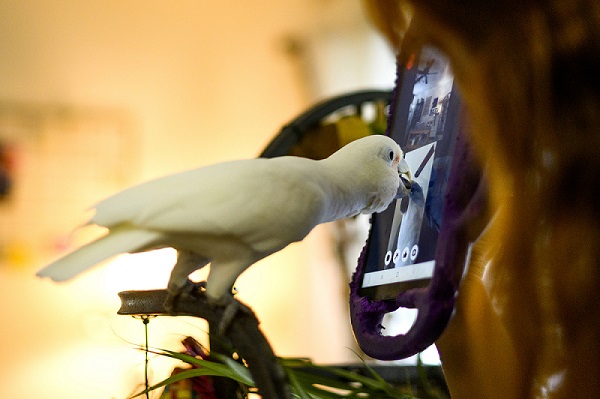
Researcher Jennifer Cunha’s 11-year-old parrot, Ellie, enjoys a video call from her Florida home.
13:11 JST, April 28, 2023
Eleanor wanted to call a friend, so she scanned her contacts and touched a picture of Rosie, whom she had met last summer.
Instead of speaking on the call, the pair communicated in different ways: singing, dancing and preening.
Eleanor and Rosie were participants in a new study to judge how pet parrots would respond to video calling other parrots. Researchers said that the 18 monitored birds loved seeing their feathered friends over a screen and that it provided them with a sense of community pets typically lack.
Companionship has been shown to increase people’s happiness, and this study found it adds joy to parrots’ lives, too.
“Part of the fun thing for me, and surprising thing, was how these parrots sort of bonded together,” researcher Ilyena Hirskyj-Douglas told The Washington Post. “They did want to video call each other; they did have preferences. All of this stuff just really speaks to how cognitively complex these parrots are, which . . . we don’t necessarily think of when we think of parrots.”
The study’s researchers had previously explored technology’s value to animals. Hirskyj-Douglas invented DogPhone, a ball that dogs can shake to call their owners. Another researcher, Rébecca Kleinberger, created Joy Branch, which allows zoo animals to play music in their pens. Jennifer Cunha has developed tablet games for parrots.
The trio wanted to explore how they could enrich birds’ lives through communication. Pet parrots are vulnerable to avian ganglioneuritis, a deadly disease contagious among birds, which can make it dangerous for pets to interact with their species, researchers said.
“A lot of them only live around humans and are very closely bonded with their humans, but that can also cause problems,” said Kleinberger, a music and computer science professor at Northeastern University.
For the video-calling study, researchers selected volunteers to take care of the parrots through Parrot Kindergarten, a Florida learning program that Cunha runs. The first hurdle was to ensure that the parrots recognized other parrots through a screen. Analysts worried that the parrots would act aggressively, but most remained calm when the video calls began.
At first, the parrots were confused – looking behind the tablet and trying to follow the other parrot through the screen. But after a few days, they appeared to recognize that the opposite parrot was in a different room, researchers said.
Caregivers trained their parrots to ring a bell to request a video call. When they chimed it, their owner delivered a tablet or smartphone and displayed pictures of the other parrots through Facebook Messenger. The parrots then used their beaks to tap the picture of a bird, and their owners started a call with the selected parrot.
A few parrots walked off, flew away or gawked, prompting the call to end. But others seemed to enjoy their newfound social life. Parrots developed friends they frequently chose to call – and the ones who frequently dialed other parrots in turn received the most calls.
Once connected, they often mimicked each other and bonded through preening, eating, dancing, singing and showing off their toys. When one tried to hang upside down, the other did, too. Sometimes, they napped together. Some parrots saw their own species for the first time in decades.
The parrots completed 212 calls, which lasted no more than five minutes, over the initial two-week testing period.
“There’ve been papers that speculate about the animal internet,” said Hirskyj-Douglas, who teaches animal and computer interactions at the University of Glasgow. “But this is the first study that’s really looked at how animals can use the internet together.”
After their initial assessment, researchers halted routine calls to see whether the parrots would choose to continue making them. They thought the parrots would revert to their lifestyles from before the experiment. Instead, the birds often rang their bells to see their friends.
“It was almost a race of who called first,” Cunha said.
The parrots learned from each other – some foraged and flew for the first time. After concluding their calls, some would immediately ring their bell again. The parrots completed 147 requested calls over about two months in the second phase, and researchers collected more than 1,000 hours of video interactions.
The study ended in September, and the results were published last week by the Association for Computing Machinery. Many parrots have continued to call each other, researchers said.
“This is really sort of the start of something much bigger,” Hirskyj-Douglas said. “How can we support various different animals online? There’s lots of animals in society for various different reasons that lack socialization, whether they could possibly be in situations, such as shelters, et cetera, where they could benefit from things like this.”
"News Services" POPULAR ARTICLE
-

American Playwright Jeremy O. Harris Arrested in Japan on Alleged Drug Smuggling
-

Japan’s Nikkei Stock Average as JGB Yields, Yen Rise on Rate-Hike Bets
-

Japan’s Nikkei Stock Average Licks Wounds after Selloff Sparked by BOJ Hike Bets (UPDATE 1)
-

Japan’s Nikkei Stock Average Buoyed by Stable Yen; SoftBank’s Slide Caps Gains (UPDATE 1)
-

Japanese Bond Yields Zoom, Stocks Slide as Rate Hike Looms
JN ACCESS RANKING
-

Keidanren Chairman Yoshinobu Tsutsui Visits Kashiwazaki-Kariwa Nuclear Power Plant; Inspects New Emergency Safety System
-

Imports of Rare Earths from China Facing Delays, May Be Caused by Deterioration of Japan-China Relations
-

University of Tokyo Professor Discusses Japanese Economic Security in Interview Ahead of Forum
-

Japan Pulls out of Vietnam Nuclear Project, Complicating Hanoi’s Power Plans
-

Govt Aims to Expand NISA Program Lineup, Abolish Age Restriction



















